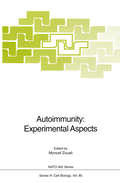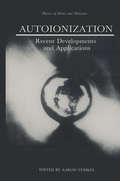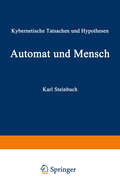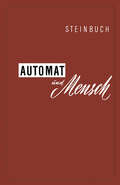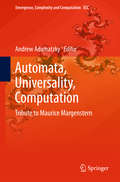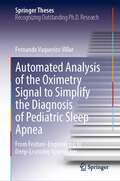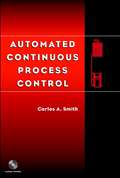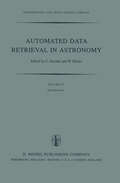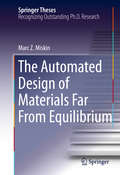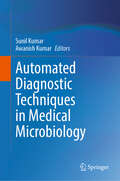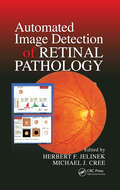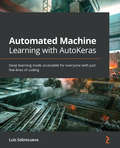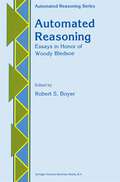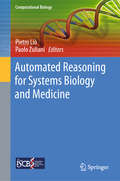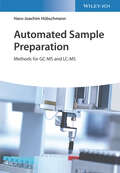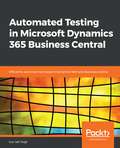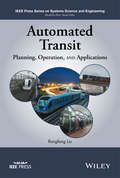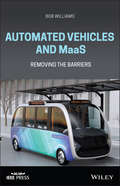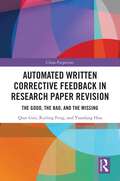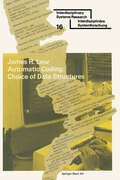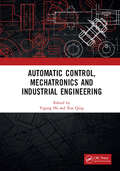- Table View
- List View
Autoimmunity: Experimental Aspects (Nato ASI Subseries H: #80)
by Moncef ZoualiCombining principles of contemporary immunology with applications to immunopathology, this up-to-date volume documents new developments in the understanding of the origin of autoimmune diseases. Emphasized are cellular and molecular approaches in both organ-specific and systemic autoimmunity. A comprehensive bibliography, numerous illustrations, and tables make it an invaluable source of information for immunologists, rheumatologists, pathologists, dermatologists, and nephrologists.
Autoionization: Recent Developments and Applications (Physics of Atoms and Molecules)
About five years ago, Professor P. G. Burke asked me to edit a sequel to an earlier book-Autoionization: Theoretical, Astrophysical, and Laboratory Experimental Aspects, edited by A. Temkin, Mono Book Corp. , Baltimore, 1966. Because so much time had gone by and so much work had been done, the prospect of updating the 1966 volume seemed out of the question. In 1965 the phenomenon of autoionization, although long known, was just starting to emerge from a comparatively intuitive stage of understanding. Three major developments characterized that development: In solar (astro-)physics, Alan Burgess (1960) had provided the resolution of the discrepancy of the temperature of the solar corona as observed versus that deduced from ionization balance calculations, by including the process of dielectronic recombination in the calculation; Madden and Codling (1963) had just performed their classic experiment revealing spectroscopically sharp lines in the midst of the photoionization continuum of the noble gases; and Feshbach (1962) had developed a theory with the explicit introduction of projection operators, which for the first time put the calculation of auto ionization states on a firm theoretical footing. There were important additional contributions made at that time as well; nevertheless, without going into further detail, we were able to include in our 1966 volume, in spite of its modest size, a not too incomplete survey of the important developments at that time. To do the equivalent now would be virtually impossible.
Automat und Mensch: Über menschliche und maschinelle Intelligenz
by Karl SteinbuchDie Fähigkeiten moderner Automaten sprengen die Grenze dessen, was einst für "mechanische" Gebilde als möglich erachtet wurde. Ihre Eigenschaften werden beschrieben in Kategorien, die bisher den Menschen vorbehalten waren, z. B. logische Verknüpfung, Zei chenerkennung, Gedächtnis, Lernen. Der Mensch ist für uns das "unbekannte Wesen" [20. 7]. Unsere Einsicht in die Funktion unseres Denksystems ist gering. Wenn nun plötzlich durch Automaten vergleichbare Eigenschaften erzeugt werden können ("künstliche Intelligenz"), erschließt sich dem for schenden Geist ein neuer Weg zum Verständnis des Menschen: Nämlich über das Verständnis der Automaten. Viele überkommene Vorstellungen müssen revidiert werden. Die Frage ist: Kann man geistige Vorgänge durch Erkenntnisse an Automaten nicht verstehen, teilweise verstehen, ganz verstehen? Die häufig gegebene Antwort, daß die Erkenntnisse der Physik für den einen Teil geistiger Vorgänge zuständig seien, für den anderen je doch nicht, ist meines Erachtens ein schlechter Kompromiß. Man muß zwar zugestehen, daß unsere heutigen Erkenntnisse nicht aus reichen, um alles oder auch nur den überwiegenden Teil zu erklären, man sollte aber keinesfalls die Vermutung akzeptieren, geistige Vorgänge unterhalb einer kritischen Organisationshöhe könne man physikalisch erklären, oberhalb dieser kritischen Organisationshöhe sei jedoch eine "überphysik" zuständig. Solche Sprünge macht die Natur nicht. In diesem Buch werden die Grundbegriffe, die zum Ver ständnis moderner Automaten erforderlich sind, erklärt. In den ersten Kapiteln herrschen deshalb technische Erläuterungen vor. Hierbei ist eine leichtverständliche Darstellung angestrebt. Mathematische Formeln wurden weitgehend vermieden, dagegen sollen Bilder das Wesentliche veranschaulichen.
Automata, Universality, Computation: Tribute to Maurice Margenstern (Emergence, Complexity and Computation #12)
by Andrew AdamatzkyThis book is an intellectually stimulating excursion into mathematical machines and structures capable for a universal computation. World top experts in computer science and mathematics overview exciting and intriguing topics of logical theory of monoids, geometry of Gauss word, philosophy of mathematics in computer science, asynchronous and parallel P-systems, decidability in cellular automata, splicing systems, reversible Turing machines, information flows in two-way finite automata, prime generators in automaton arrays, Grossone and Turing machines, automaton models of atomic lattices. The book is full of visually attractive examples of mathematical machines, open problems and challenges for future research. Those interested in the advancement of a theory of computation, philosophy of mathematics, future and emergent computing paradigms, architectures and implementations will find the book vital for their research and development.
Automated Analysis of the Oximetry Signal to Simplify the Diagnosis of Pediatric Sleep Apnea: From Feature-Engineering to Deep-Learning Approaches (Springer Theses)
by Fernando Vaquerizo VillarThis book describes the application of novel signal processing algorithms to improve the diagnostic capability of the blood oxygen saturation signal (SpO2) from nocturnal oximetry in the simplification of pediatric obstructive sleep apnea (OSA) diagnosis. For this purpose, 3196 SpO2 recordings from three different databases were analyzed using feature-engineering and deep-learning methodologies. Particularly, three novel feature extraction algorithms (bispectrum, wavelet, and detrended fluctuation analysis), as well as a novel deep-learning architecture based on convolutional neural networks are proposed. The proposed feature-engineering and deep-learning models outperformed conventional features from the oximetry signal, as well as state-of-the-art approaches. On the one hand, this book shows that bispectrum, wavelet, and detrended fluctuation analysis can be used to characterize changes in the SpO2 signal caused by apneic events in pediatric subjects. On the other hand, it demonstrates that deep-learning algorithms can learn complex features from oximetry dynamics that allow to enhance the diagnostic capability of nocturnal oximetry in the context of childhood OSA. All in all, this book offers a comprehensive and timely guide to the use of signal processing and AI methods in the diagnosis of pediatric OSA, including novel methodological insights concerning the automated analysis of the oximetry signal. It also discusses some open questions for future research.
Automated Continuous Process Control
by Carlos A. SmithAutomated Continuous Process Control pulls together–in one compact and practical volume–the essentials for understanding, designing, and operating process control systems. This comprehensive guide covers the major elements of process control in a well-defined and ordered framework. Concepts are clearly presented, with minimal reliance on mathematical equations and strong emphasis on practical, real-life examples. Beginning with the very basics of process control, Automated Continuous Process Control builds upon each chapter to help the reader understand and efficiently practice industrial process control. This complete presentation includes: A discussion of processes from a physical point of view Feedback controllers and the workhorse in the industry–the PID controller The concept and implementation of cascade control Ratio, override (or constraint), and selective control Block diagrams and stability Feedforward control Techniques to control processes with long dead times Multivariable process control Applicable for electrical, industrial, chemical, or mechanical engineers, Automated Continuous Process Control offers proven process control guidance that can actually be used in day-to-day operations. The reader will also benefit from the companion CD-ROM, which contains processes that have been successfully used for many years to practice tuning feedback and cascade controllers, as well as designing feedforward controllers.
Automated Data Retrieval in Astronomy: Proceedings of the 64th Colloquium of the International Astronomical Union held in Strasbourg, France, July 7–10, 1981 (Astrophysics and Space Science Library #97)
by Carlos Jaschek W. HeintzThe idea of this Colloquium came during the XVIIth General Assembly of the I. A. U. at Montreal. The meeting was organized under the auspices of I. A. U. Commission 5 (Documentation and Astronomical Data). The Scientific Organizing Committee consisted of C. Jaschek (chairperson), O. Dluzhnevskaya, B. Hauck (vice chairperson), W. Heintz, P. Lantos, Th. Lederle, J. Mead~ G. Ruben, Y. Terashita, G. Wilkins. The members of this Committee are to be thanked for their devotion to the organization of what turned out to be a very successful meeting. The program was organized so as to cover most of the aspects concerning work with machine readable data. In a certain sense it is the develop ment of the subjects of I. A. U. Colloquium 35 "Compilation, critical evaluation and distribution of stellar data" held at Strasbourg in 1976. The meeting was opened by welcoming addresses delivered by Dr A. Florsch, Director of the Strasbourg Observatory, Prof. H. Curien, President of the European Science Foundation and Prof. W. Heintz, President of I. A. U. Commission 5. The sessions were devoted to the fol lowing subjects : Existing data centers, Data networks, New hardware, Recent software developments, Bibliographical services, Copyright, Editorial policies and nomenclature, Data in astronomy and Data in space astronomy. The different sessions were chaired by G. A. Pilkins, J. Mead, S. Lavrov, W. Heintz, P. Lantos, M. McCarthy, J. Delhaye and G. Westerhout. On July 9. Dr A.
The Automated Design of Materials Far From Equilibrium (Springer Theses)
by Marc Z. MiskinThis thesis conceptualizes and implements a new framework for designing materials that are far from equilibrium. Starting with state-of-the-art optimization engines, it describes an automated system that makes use of simulations and 3D printing to find the material that best performs a user-specified goal. Identifying which microscopic features produce a desired macroscopic behavior is a problem at the forefront of materials science. This task is materials design, and within it, new goals and challenges have emerged from tailoring the response of materials far from equilibrium. These materials hold promising properties such as robustness, high strength, and self-healing. Yet without a general theory to predict how these properties emerge, designing and controlling them presents a complex and important problem. As proof of concept, the thesis shows how to design the behavior of granular materials, i.e., collections of athermal, macroscopic identical objects, by identifying the particle shapes that form the stiffest, softest, densest, loosest, most dissipative and strain-stiffening aggregates. More generally, the thesis shows how these results serve as prototypes for problems at the heart of materials design, and advocates the perspective that machines are the key to turning complex material forms into new material functions.
Automated Diagnostic Techniques in Medical Microbiology
by Sunil Kumar Awanish KumarThis book will explore the knowledge of current diagnostic automation techniques applied in the field of clinical microbiology, tropical diseases, POCT, etc. There is no such type of book related to this topic. This book will help clinicians, microbiologists, and researchers to make diagnostic algorithms for infectious diseases and help them in early diagnosis. Automation in clinical microbiology has revolutionized routine practice in diagnostic cum research in medical microbiology. This book covers the recent updates and advances in diagnostic microbiology and provides new techniques related to Genomic, Proteomic, and metabolomics in microbiology. This book will intensely discuss the new and innovative automation techniques available for diagnosis in the microbiology laboratory. This book is more focused on automation techniques, which are used in the early detection of infectious diseases even caused by rare microorganisms. Furthermore, this book has complied with the chapters that provide insights to readers with comprehensive and usable knowledge on automation techniques in diagnostic microbiology.
Automated Image Detection of Retinal Pathology
by Herbert Jelinek Michael J. CreeDiscusses the Effect of Automated Assessment Programs on Health Care ProvisionDiabetes is approaching pandemic numbers, and as an associated complication, diabetic retinopathy is also on the rise. Much about the computer-based diagnosis of this intricate illness has been discovered and proven effective in research labs. But, unfortunately, many of
Automated Machine Learning With Autokeras: Deep Learning Made Accessible For Everyone With Just Few Lines Of Coding
by Luis SobrecuevaDeep learning made accessible for everyone with just few lines of coding
Automated Reasoning: Essays in Honor of Woody Bledsoe (Automated Reasoning Series #1)
by Robert Stephen BoyerThese essays have been written to honor W. W. Bledsoe, a scientist who has contributed to such diverse fields as mathematics, systems analysis, pattern recognition, biology, artificial intelligence, and automated reasoning. The first essay provides a sketch of his life, emphasizing his scientific contributions. The diversity of the fields to which Bledsoe has contributed is reflected in the range of the other essays, which are original scientific contributions by some of his many friends and colleagues. Bledsoe is a founding father of the field of automated reasoning, and a majority of the essays are on that topic. These essays are collected together here not only to acknowledge Bledsoe's manifold and substantial scientific contributions but also to express our appreciation for the great care and energy that he has devoted to nurturing many of the scientists working in those scientific fields he has helped found. Robert S. Boyer Austin February, 1991 ix Acknow ledgements Thanks to Larry Wos, editor of the Journal of Automated Reasoning, and Derek Middleton and Martin Scrivener, Kluwer Academic editors, for sup porting the idea of initiating this collection of essays. Thanks to A. Michael Ballantyne and Michael Spivak, for help with lffi.TWC, especially in identifying many formatting problems and providing fixes.
Automated Reasoning for Systems Biology and Medicine (Computational Biology #30)
by Pietro Liò Paolo ZulianiThis book presents outstanding contributions in an exciting, new and multidisciplinary research area: the application of formal, automated reasoning techniques to analyse complex models in systems biology and systems medicine. Automated reasoning is a field of computer science devoted to the development of algorithms that yield trustworthy answers, providing a basis of sound logical reasoning. For example, in the semiconductor industry formal verification is instrumental to ensuring that chip designs are free of defects (or “bugs”). Over the past 15 years, systems biology and systems medicine have been introduced in an attempt to understand the enormous complexity of life from a computational point of view. This has generated a wealth of new knowledge in the form of computational models, whose staggering complexity makes manual analysis methods infeasible. Sound, trusted, and automated means of analysing the models are thus required in order to be able to trust their conclusions. Above all, this is crucial to engineering safe biomedical devices and to reducing our reliance on wet-lab experiments and clinical trials, which will in turn produce lower economic and societal costs. Some examples of the questions addressed here include: Can we automatically adjust medications for patients with multiple chronic conditions? Can we verify that an artificial pancreas system delivers insulin in a way that ensures Type 1 diabetic patients never suffer from hyperglycaemia or hypoglycaemia? And lastly, can we predict what kind of mutations a cancer cell is likely to undergo? This book brings together leading researchers from a number of highly interdisciplinary areas, including: · Parameter inference from time series · Model selection · Network structure identification · Machine learning · Systems medicine · Hypothesis generation from experimental data · Systems biology, systems medicine, and digital pathology · Verification of biomedical devices “This book presents a comprehensive spectrum of model-focused analysis techniques for biological systems ...an essential resource for tracking the developments of a fast moving field that promises to revolutionize biology and medicine by the automated analysis of models and data.”Prof Luca Cardelli FRS, University of Oxford
Automated Sample Preparation: Methods for GC-MS and LC-MS
by Hans-Joachim HubschmannAn essential guide to the proven automated sample preparation process While the measurement step in sample preparation is automated, the sample handling step is manual and all too often open to risk and errors. The manual process is of concern for accessing data quality as well as producing limited reproducibility and comparability. Handbook of Automated Sample Preparation for CG-MS and LC-MS explores the advantages of implementing automated sample preparation during the handling phase for CG-MS and LC-MS. The author, a noted expert on the topic, includes information on the proven workflows that can be put in place for many routine and regulated analytical methods. This book offers a guide to automated workflows for both on-line and off-line sample preparation. This process has proven to deliver consistent and comparable data quality, increased sample amounts, and improved cost efficiency. In addition, the process follows Standard Operation Procedures that are essential for audited laboratories. This important book: Provides the information and tools needed for the implementation of instrumental sample preparation workflows Offers proven and detailed examples that can be adapted in analytical laboratories Shows how automated sample preparation can reduce cost per sample, increase sample amounts, and produce faster results Includes illustrative examples from various fields such as chemistry to food safety and pharmaceuticals Written for personnel in analytical industry, pharmaceutical, and medical laboratories, Handbook of Automated Sample Preparation for CG-MS and LC-MS offers the much-needed tools for implementing the automated sample preparation for analytical laboratories.
Automated Sample Preparation: Methods for GC-MS and LC-MS
by Hans-Joachim HubschmannAn essential guide to the proven automated sample preparation process While the measurement step in sample preparation is automated, the sample handling step is manual and all too often open to risk and errors. The manual process is of concern for accessing data quality as well as producing limited reproducibility and comparability. Handbook of Automated Sample Preparation for CG-MS and LC-MS explores the advantages of implementing automated sample preparation during the handling phase for CG-MS and LC-MS. The author, a noted expert on the topic, includes information on the proven workflows that can be put in place for many routine and regulated analytical methods. This book offers a guide to automated workflows for both on-line and off-line sample preparation. This process has proven to deliver consistent and comparable data quality, increased sample amounts, and improved cost efficiency. In addition, the process follows Standard Operation Procedures that are essential for audited laboratories. This important book: Provides the information and tools needed for the implementation of instrumental sample preparation workflows Offers proven and detailed examples that can be adapted in analytical laboratories Shows how automated sample preparation can reduce cost per sample, increase sample amounts, and produce faster results Includes illustrative examples from various fields such as chemistry to food safety and pharmaceuticals Written for personnel in analytical industry, pharmaceutical, and medical laboratories, Handbook of Automated Sample Preparation for CG-MS and LC-MS offers the much-needed tools for implementing the automated sample preparation for analytical laboratories.
Automated Testing in Microsoft Dynamics 365 Business Central: Efficiently Automate Test Cases In Dynamics Nav And Business Central
by Luc Van VugtDynamics 365 Business Central is the new Cloud-based SaaS ERP proposition from Microsoft. It’s not as simple as it used to be way back when it was called Navigator, Navision Financials, or Microsoft Business Solutions-Navision. Our development practices are becoming more formal, and with this the call for test automation is pressing on us. This book will teach you to leverage testing tools available with Dynamics 365 Business Central to perform automated testing.
Automated Transit: Planning, Operation, and Applications (IEEE Press Series on Systems Science and Engineering)
by Rongfang LiuA comprehensive discussion of automated transit This book analyzes the successful implementations of automated transit in various international locations, such as Paris, Toronto, London, and Kuala Lumpur, and investigates the apparent lack of automated transit applications in the urban environment in the United States. The book begins with a brief definition of automated transit and its historical development. After a thorough description of the technical specifications, the author highlights a few applications from each sub-group of the automated transit spectrum. International case studies display various technologies and their applications, and identify vital factors that affect each system and performance evaluations of existing applications. The book then discusses the planning and operation of automated transit applications at both macro and micro levels. Finally, the book covers a number of less successful concepts, as well as the lessons learned, allowing readers to gain a comprehensive understanding of the topic. Key features: Provides a thorough examination of automated transit applications, their impact and implications for society Written by the committee chair for the Automated Transit Systems Transportation, Research Board Offers essential information on planning, costs, and applications of automated transit systems Covers driverless metros, automated LRT, group and personal rapid transit, a review of worldwide applications Includes capacity and safety guidelines, as well as vehicles, propulsion, and communication and control systems This book is essential reading for engineers, researchers, scientists, college or graduate students who work in transportation planning, engineering, operation and management fields.
Automated Transit: Planning, Operation, and Applications (IEEE Press Series on Systems Science and Engineering)
by Rongfang LiuA comprehensive discussion of automated transit This book analyzes the successful implementations of automated transit in various international locations, such as Paris, Toronto, London, and Kuala Lumpur, and investigates the apparent lack of automated transit applications in the urban environment in the United States. The book begins with a brief definition of automated transit and its historical development. After a thorough description of the technical specifications, the author highlights a few applications from each sub-group of the automated transit spectrum. International case studies display various technologies and their applications, and identify vital factors that affect each system and performance evaluations of existing applications. The book then discusses the planning and operation of automated transit applications at both macro and micro levels. Finally, the book covers a number of less successful concepts, as well as the lessons learned, allowing readers to gain a comprehensive understanding of the topic. Key features: Provides a thorough examination of automated transit applications, their impact and implications for society Written by the committee chair for the Automated Transit Systems Transportation, Research Board Offers essential information on planning, costs, and applications of automated transit systems Covers driverless metros, automated LRT, group and personal rapid transit, a review of worldwide applications Includes capacity and safety guidelines, as well as vehicles, propulsion, and communication and control systems This book is essential reading for engineers, researchers, scientists, college or graduate students who work in transportation planning, engineering, operation and management fields.
Automated Vehicles and MaaS: Removing the Barriers (Wiley - IEEE)
by Bob WilliamsAUTOMATED VEHICLES AND MaaS A topical overview of the issues facing automated driving systems and Mobility as a Service, identifies the obstacles to implementation and offers potential solutionsAdvances in cooperative and automated vehicle (CAV) technologies, cultural and socio-economic shifts, measures to combat climate change, social pressures to reduce road deaths and injuries, and changing attitudes toward self-driving cars, are creating new and exciting mobility scenarios worldwide. However, many obstacles remain and are compounded by the consequences of COVID-19. Mobility as a Service (MaaS) integrates various forms of public and private transport services into a single on-demand mobility service. Combining trains, cars, buses, bicycles, and other forms of transport, MaaS promises a convenient, cost-effective, and eco-friendly alternative to private automobiles.Automated Vehicles and MaaS: Removing the Barriers is an up-to-date overview of the contemporary challenges facing CAVs and MaaS. Written in a clear and accessible style, this timely volume summarizes recent research studies, describes the evolution of automated driving systems and MaaS, identifies the barriers to their widespread adoption, and proposes potential solutions to overcome and remove these barriers. The text focuses on the claims, realities, politics, new organizational roles, and implementation problems associated with CAVs and MaaS—providing industry professionals, policymakers, planners, administrators, and investors with a clear understanding of the issues facing the introduction of automated driving systems and MaaS. This important guide and reference:Provides an overview of recent progress, the current state of the art, and discussion of future objectivesPresents both technical background and general overview of automated driving systems and MaaSCovers political, commercial, and practical issues, as well as technical and research content, yet suitable for non-specialistsHelps readers make informed decisions and realistic estimates for implementing mobility solutions and new business models for transport servicesIncludes an extensive bibliography with direct links to in-depth technical engineering and research informationAutomated Vehicles and MaaS: Removing the Barriers is an essential resource for transport providers, vehicle manufacturers, urban and transport planners, students of transportation, vehicle technology, and urban planning, and transport policy and strategy managers, advisors, and reviewers.
Automated Vehicles and MaaS: Removing the Barriers (Wiley - IEEE)
by Bob WilliamsAUTOMATED VEHICLES AND MaaS A topical overview of the issues facing automated driving systems and Mobility as a Service, identifies the obstacles to implementation and offers potential solutionsAdvances in cooperative and automated vehicle (CAV) technologies, cultural and socio-economic shifts, measures to combat climate change, social pressures to reduce road deaths and injuries, and changing attitudes toward self-driving cars, are creating new and exciting mobility scenarios worldwide. However, many obstacles remain and are compounded by the consequences of COVID-19. Mobility as a Service (MaaS) integrates various forms of public and private transport services into a single on-demand mobility service. Combining trains, cars, buses, bicycles, and other forms of transport, MaaS promises a convenient, cost-effective, and eco-friendly alternative to private automobiles.Automated Vehicles and MaaS: Removing the Barriers is an up-to-date overview of the contemporary challenges facing CAVs and MaaS. Written in a clear and accessible style, this timely volume summarizes recent research studies, describes the evolution of automated driving systems and MaaS, identifies the barriers to their widespread adoption, and proposes potential solutions to overcome and remove these barriers. The text focuses on the claims, realities, politics, new organizational roles, and implementation problems associated with CAVs and MaaS—providing industry professionals, policymakers, planners, administrators, and investors with a clear understanding of the issues facing the introduction of automated driving systems and MaaS. This important guide and reference:Provides an overview of recent progress, the current state of the art, and discussion of future objectivesPresents both technical background and general overview of automated driving systems and MaaSCovers political, commercial, and practical issues, as well as technical and research content, yet suitable for non-specialistsHelps readers make informed decisions and realistic estimates for implementing mobility solutions and new business models for transport servicesIncludes an extensive bibliography with direct links to in-depth technical engineering and research informationAutomated Vehicles and MaaS: Removing the Barriers is an essential resource for transport providers, vehicle manufacturers, urban and transport planners, students of transportation, vehicle technology, and urban planning, and transport policy and strategy managers, advisors, and reviewers.
Automated Written Corrective Feedback in Research Paper Revision: The Good, The Bad, and The Missing (China Perspectives)
by Qian Guo Ruiling Feng Yuanfang HuaThis book studies the use of an automated writing evaluation (AWE) systems in research paper revision for publication purposes by Chinese doctoral students.Research writing skills are essential for achieving academic status, and AWE tools can be a great companion on the journey. However, AWE tools may provide a disservice if users do not stay alert to inaccurate feedback, inaccurate correction suggestions, and missed errors. The effects of accurate feedback on revision outcomes have been the focus of a number of AWE studies, but student engagement and revision results in cases of inaccurate feedback and missed errors have rarely been investigated. Such investigations can provide practical advice on using automated feedback in research writing. This book provides a comprehensive evaluation of AWE tools and profiles student engagement with tool use in cases of different qualities of feedback. It can empower novice scholars and improve the effectiveness of academic writing instructors. The findings can also inform AWE system developers about possible ways of system improvement for research paper writing.The book will be particularly useful to students and scholars of language and linguistic studies, education, and academic English writing.
Automated Written Corrective Feedback in Research Paper Revision: The Good, The Bad, and The Missing (China Perspectives)
by Qian Guo Ruiling Feng Yuanfang HuaThis book studies the use of an automated writing evaluation (AWE) systems in research paper revision for publication purposes by Chinese doctoral students.Research writing skills are essential for achieving academic status, and AWE tools can be a great companion on the journey. However, AWE tools may provide a disservice if users do not stay alert to inaccurate feedback, inaccurate correction suggestions, and missed errors. The effects of accurate feedback on revision outcomes have been the focus of a number of AWE studies, but student engagement and revision results in cases of inaccurate feedback and missed errors have rarely been investigated. Such investigations can provide practical advice on using automated feedback in research writing. This book provides a comprehensive evaluation of AWE tools and profiles student engagement with tool use in cases of different qualities of feedback. It can empower novice scholars and improve the effectiveness of academic writing instructors. The findings can also inform AWE system developers about possible ways of system improvement for research paper writing.The book will be particularly useful to students and scholars of language and linguistic studies, education, and academic English writing.
Automatic Coding: Choice of Data Structures (Interdisciplinary Systems Research)
by LOW1.0 2 information structures, and the runtime efficiency available using lower level data structures. We believe these runtime inefficiencies can be remedied by providing a library of representations for the information structures and a user assisted automatic system to choose appropriate elements from this library for the user's programs. The main problems in such an automatic approach are: 1). Building a library of representations; 2). Characterizing the properties of these representations; 3). understanding how the user's program actually uses the abstract information structures; and -4). efficiently matching the user program needs with the properties of the known representations. The research reported here is an attempt to demonstrate the feasibility of such automatic representation selection. We allow the user to express data in terms of relations, sets, and sequences. Our system then obtains information by analysis of the program, execution statement profiles and interrogation of the user. Using that information, the system selects efficient (in terms of time and space) low level implementations for the user's information structures from a fixed library of information structure representations. Though we have considered only a few abstract information structures (those available in our programming language, SAIL) we believe the techniques used in this system are generally applicable.
Automatic Control, Mechatronics and Industrial Engineering: Proceedings of the International Conference on Automatic Control, Mechatronics and Industrial Engineering (ACMIE 2018), October 29-31, 2018, Suzhou, China
Engineering technology development and implementation play an important role in making the industry more sustainable in an increasingly competitive world. This book covers significant recent developments in both fundamental and applied research in the engineering field. Domains of application include, but are not limited to, Intelligent Control Systems and Optimization, Signal Processing, Sensors, Systems Modeling and Control, Robotics and Automation, Industrial and Electric Engineering, Production and Management. This book is an excellent reference work to get up to date with the latest research and developments in the fields of Automation, Mechatronics and Industrial Engineering. It aims to provide a platform for researchers and professionals in all relevant fields to gain new ideas and establish great achievements in scientific development.
